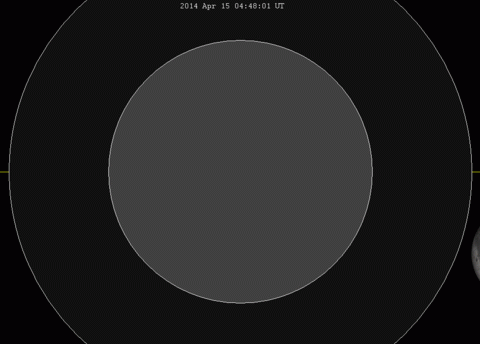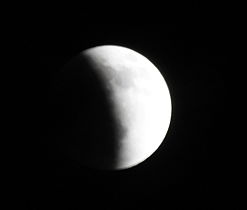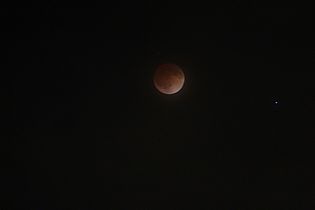|
April 2014 lunar eclipse
A total lunar eclipse occurred at the Moon’s ascending node of orbit on Tuesday, April 15, 2014,[1] with an umbral magnitude of 1.2918. A lunar eclipse occurs when the Moon moves into the Earth's shadow, causing the Moon to be darkened. A total lunar eclipse occurs when the Moon's near side entirely passes into the Earth's umbral shadow. Unlike a solar eclipse, which can only be viewed from a relatively small area of the world, a lunar eclipse may be viewed from anywhere on the night side of Earth. A total lunar eclipse can last up to nearly two hours, while a total solar eclipse lasts only a few minutes at any given place, because the Moon's shadow is smaller. The Moon's apparent diameter was near the average diameter because it occurred 6.9 days after apogee (on April 8, 2014, at 10:50 UTC) and 7.6 days before perigee (on April 22, 2014, at 20:20 UTC).[2] This lunar eclipse is the first of a tetrad, with four total lunar eclipses in series, the others being on October 8, 2014; April 4, 2015; and September 28, 2015. BackgroundA lunar eclipse occurs when the Moon passes within Earth's umbra (shadow). As the eclipse begins, the Earth's shadow first darkens the Moon slightly. Then, the shadow begins to "cover" part of the Moon, turning it a dark red-brown color (typically - the color can vary based on atmospheric conditions). The Moon appears to be reddish because of Rayleigh scattering (the same effect that causes sunsets to appear reddish) and the refraction of that light by the Earth's atmosphere into its umbra.[3] The following simulation shows the approximate appearance of the Moon passing through the Earth's shadow. The Moon's brightness is exaggerated within the umbral shadow. The northern portion of the Moon was closest to the center of the shadow, making it darkest, and most red in appearance.  Description  On April 15, 2014, the Moon passed through the southern part of the Earth's umbral shadow.[4] It was visible over most of the western hemisphere, including eastern Australia, New Zealand, the Pacific Ocean, and the Americas.[5] In the western Pacific, the first half of the eclipse occurred before moonrise. In Europe and Africa, the eclipse began just before moonset.[4] Mars, which had just passed its opposition, appeared at magnitude -1.5 about 9.5° northwest of the Moon.[5][4][6][7] Spica was 2° to the west, while Arcturus was 32° north. Saturn was 26° east and Antares 44° southeast.[4] The Moon entered Earth's penumbral shadow at 4:53:40 UTC and the umbral shadow at 5:58:19. Totality lasted for 1 hour 17.8 minutes, from 7:06:46 to 8:24:34. The moment of greatest eclipse occurred at 7:45:39. At that point, the Moon's zenith was approximately 3,000 kilometres (1,900 mi) southwest of the Galápagos Islands. The Moon left the umbral shadow at 9:33:02 and the penumbral shadow at 10:37:33.[4] The peak umbral magnitude was 1.29177, at which moment the northern part of the moon was 1.7 arc-minutes south of the center of Earth's shadow, while the southern part was 40.0 arc-minutes from center. The gamma of the eclipse was −0.3017.[4] The eclipse was a member of Lunar Saros 122. It was the 56th such eclipse.[4]
Timing
* The penumbral phase of the eclipse changes the appearance of the Moon only slightly and is generally not noticeable.[8] 
Viewing eventsMany museums and observatories planned special events for the eclipse. The United States National Park Service sponsored events at Great Basin National Park and Sleeping Bear Dunes National Lakeshore.[10] The University of Hawaii's Institute for Astronomy held events at two locations on the islands.[11] The Griffith Observatory in Los Angeles, California streamed the eclipse live on the Internet.[5] NASA hosted two live question-and-answer sessions online. The first happened roughly 12 hours before the eclipse via Reddit's Ask Me Anything. The second was a web chat hosted on NASA's site just before the eclipse began. NASA also streamed the eclipse live on their website.[12] NASA TV provided 3 hours of live coverage beginning at 2 a.m. EDT.[13] Gallery
Relation to prophecyStarting in 2008, Christian pastors John Hagee and Mark Biltz began teaching "blood moon prophecies": Biltz said the Second Coming of Jesus would occur at the end of the tetrad that began with the April 2014 eclipse, while Hagee said only that the tetrad is a sign of something significant.[14] The idea gained popular media attention in the United States, and prompted a response from the scientific radio show Earth & Sky.[5][15] According to Christian Today, only a "small group of Christians" saw the eclipse as having religious significance, despite the attention.[16] Eclipse detailsShown below is a table displaying details about this particular solar eclipse. It describes various parameters pertaining to this eclipse.[17]
Eclipse seasonThis eclipse is part of an eclipse season, a period, roughly every six months, when eclipses occur. Only two (or occasionally three) eclipse seasons occur each year, and each season lasts about 35 days and repeats just short of six months (173 days) later; thus two full eclipse seasons always occur each year. Either two or three eclipses happen each eclipse season. In the sequence below, each eclipse is separated by a fortnight.
Related eclipsesEclipses in 2014
Metonic
Tzolkinex
Half-Saros
Tritos
Lunar Saros 122
Inex
Triad
Lunar eclipses of 2013–2016This eclipse is a member of a semester series. An eclipse in a semester series of lunar eclipses repeats approximately every 177 days and 4 hours (a semester) at alternating nodes of the Moon's orbit.[18] The penumbral lunar eclipse on May 25, 2013 occurs in the previous lunar year eclipse set, and the penumbral lunar eclipse on August 18, 2016 occurs in the next lunar year eclipse set.
Half-Saros cycleA lunar eclipse will be preceded and followed by solar eclipses by 9 years and 5.5 days (a half saros).[19] This lunar eclipse is related to two hybrid total/annualar solar eclipses of solar saros 129.
See alsoReferences
External linksWikimedia Commons has media related to Lunar eclipse of 2014 April 15.
|
||||||||||||||||||||||||||||||||||||||||||||||||||||||||||||||||||||||||||||||||||||||||||||||||||||||||||||||||||||||||||||||||||||||||||||||||||||||||||||||||||||||||||||||||||||||||||||||||||||||||||||||||||||||||||||||||||||||||||||||





















































